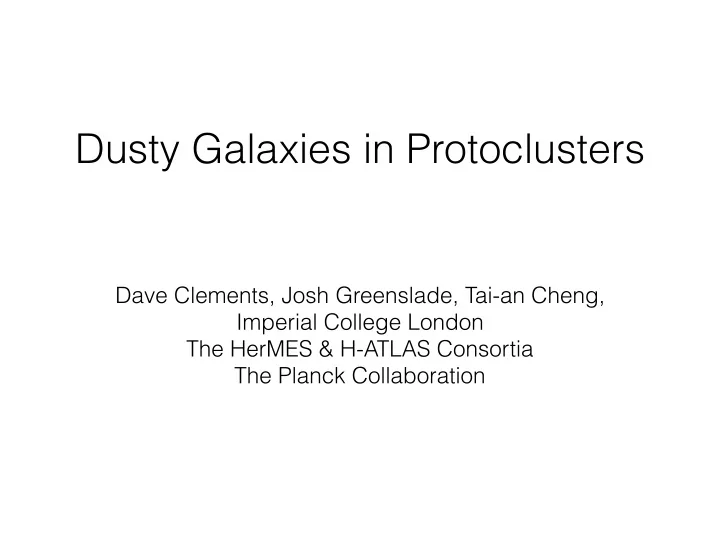

Dusty Galaxies in Protoclusters Dave Clements, Josh Greenslade, Tai-an Cheng, Imperial College London The HerMES & H-ATLAS Consortia The Planck Collaboration
Massive Cluster Galaxy Formation • How do high mass (>10 11 M sun ) cluster galaxies form? • Mostly massive old, red & dead ellipticals • Colours imply they formed at high redshift but high z clusters difficult to find • The few known high z (z=2-5) protoclusters (Casey, 2016) each host several massive starburst galaxies • How to find more? How do they work?
Dusty Protoclusters Two protoclusters at z=2.1 and z=2.47 in COSMOS. Red & blue dots are DSFGs (Casey et al 2015, Yuen et al. 2014)
Models: Granato et al. Forming cluster at z=2: luminosity in SPIRE bands
Far-IR Surveys HerMES & H-ATLAS fields • Far-IR surveys excellent at finding high SFR source but need large area: Herschel &/or Planck
Herschel-Planck Approach • Look at Herschel images of Planck sources in ~1000 sq. deg. covered by large surveys Known Sources: 58% Largely known local galaxies such as NGC5012 shown here. Identi fj able by resolved emission in Herschel and cross matches to catalogues. Galactic Cirrus: 24% Identi fj able through extended emission in Herschel & IRAS, absence of known cataloged sources. Protocluster Candidates: 14% Overdensities of Herschel sources, no extended emission, no extant identi fj cation, no extended IRAS emission. 59 of these are found, de- tails in Greenslade et al., in prep Plus 3% strong lensing candidates and 1% stars. Clements et al., 2014 Greenslade et al., in prep
Herschel-Planck Followup SCUBA2, SMA, Radio, Optic • SCUBA2 (& LABOCA) data extends SED from Planck Herschel SCUBA2 250 to 850 microns • Allows photo-z estimate • Helps cross IDs Clements et al., 2016
Clements et al., 2016
Cheng et al. in prep
Cheng et al. in prep I J H Ks 3.6μm 4.5μm 29/30
Cheng et al. in prep I J H Ks 3.6μm 4.5μm 29/30 Cheng et al. in prep
Bootes Clump z~2.27 Clements et al., 2014 • Planck ERCSC source, overdensity in Herschel, photo-z peak at z=2.27
Herschel Clump Source colours Greenslade et al. in prep
Planck Colours Greenslade et al. in prep Suggests this approach is sensitive to at least some warmer, lower z clusters
Herschel-Planck Protoclusters • 59 candidate dusty protoclusters in Herschel surveys • Compare to Granato et al. (2015) physical models of cluster galaxy formation • Groups of starbursts predicted in clusters but not as bright or numerous as we find • But overall counts do match Negrello et al. (in prep) analytic model 10 10 545GHz 10 8 dN/d log F (sr − 1 ) 10 6 10 4 10 2 10 0 Planck (PCXXXIX) 10 − 2 simulations (S/N > 5 ) un-lensed proto-spheroids proto-clusters 10 − 4 10 0 10 1 10 2 10 3 10 4 F (mJy) Granato et al., 2015 Negrello et al., in prep
How do these clumps work? • Submm confirmation: 35 improves photo-z & CLS UDS Planck over-densities 30 helps identification Number of Sources 25 • Detection of non-SB 20 cluster members 15 • Cross-IDs for DSFGs 10 5 • Spectroscopic redshifts 0 0 2 4 6 Redshift • Deeper studies of Lya Mackenzie et al., submitted: detected clusters 61 candidates, 51 confirmed (rest are lenses)
• Is rapid star formation restricted to the luminous DSFGs, as a result of merging? • Or are all galaxies in a protocluster forming stars at an increased rate eg. through cold gas infall? Casey, 2016
Radio Followup SPIRE 250 greyscale 6GHz flux prediction for with ATCA 5GHz contours. 16mJy 350 micron source Source IDs & unexpected FR1. from radio-FIR relation VLA data coming
Current Status • Planck source identification yields plentiful candidate high z star bursting cluster candidates • Potentially revealing a brief but formative phase of cluster evolution • SCUBA2 & SPIRE followup constrains redshifts & other properties but spectroscopy needed and underlying cluster galaxies need to be studied as well • Other approaches (eg. looking at optically selected high z cluster candidates) also promising
What Next?: SPICA • Proposed ESA- JAXA mission for mid to far-IR spectroscopy • 2.5m diameter, telescope cooled to 8K • Two instruments: mid-IR & far-IR
Positive AGN Feedback? • z=3.65 QSO • Green is 8GHz radio, red is 850micron dust • CO 1-0 & higher res. 20GHz radio coming • Jet induced star formation??
Recommend
More recommend